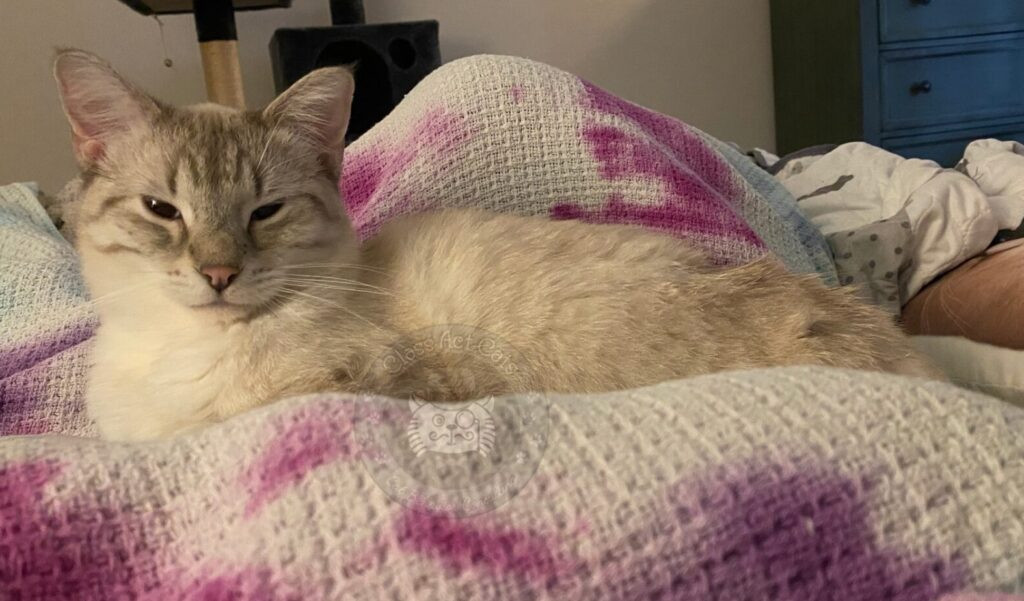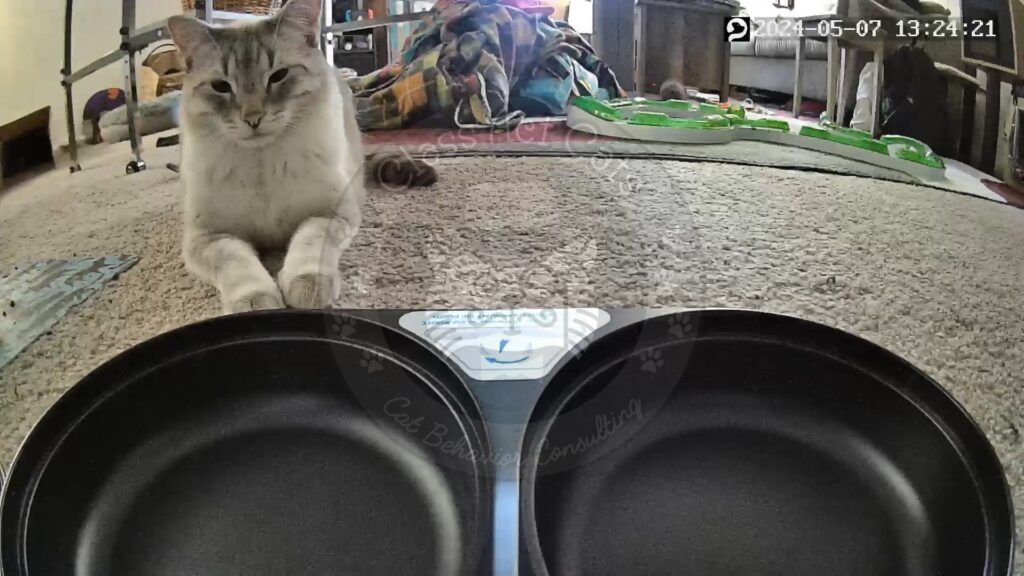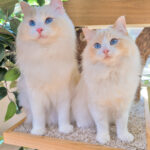As a cat owner, you’re always looking for ways to make your feline’s life happier and healthier. Pet tech has advanced significantly, offering solutions to everyday pet care challenges. While some gadgets are unnecessary, others, like automatic feeders, can be incredibly beneficial. If you’re considering a Cat With Automatic Feeder, you’ve come to the right place. Let’s explore why these devices are gaining popularity and whether one could be a good fit for your cat.
It’s important to clarify upfront: automatic feeders are not a substitute for responsible pet ownership. Leaving your cat alone for extended periods, relying solely on an automatic feeder, is not recommended. Cats need daily check-ins, even if they have a feeder. However, for daily management and addressing specific behavioral issues while you are home, automatic feeders are exceptionally useful. In fact, I personally use one for my own cats and frequently recommend them to my clients.
The Benefits of Using an Automatic Cat Feeder
Why are automatic feeders so highly recommended? They address several common cat behaviors that owners often seek help with. The most frequent reason I suggest a cat with automatic feeder is to combat early morning wake-up calls. This was actually my primary motivation for getting one myself! I won’t point fingers at which of my cats is the early riser demanding breakfast, but suffice it to say, an automatic feeder has brought peace back to my mornings.
 Poutine the cat lounging on a tie-dye blanket, looking playful and slightly mischievous.
Poutine the cat lounging on a tie-dye blanket, looking playful and slightly mischievous.
By using an automatic feeder, you remove yourself from the immediate feeding process. Your cat learns to associate mealtime with the feeder, not with you. The feeder dispenses food at programmed times, allowing you to sleep in undisturbed while your cat enjoys their breakfast.
Beyond early wake-ups, automatic feeders are invaluable for managing other feeding-related behaviors. If your cat is overly food-focused or prone to overeating, portion control is crucial. Veterinarians often recommend feeding cats multiple small meals throughout the day, mimicking their natural eating patterns. This approach helps them feel full and can aid in weight management. However, providing several small meals manually can be challenging with busy schedules. An automatic cat with automatic feeder makes this easy, dispensing smaller, controlled portions at regular intervals, even when you’re not home.
A quick tip: For cats who eat too quickly, consider combining an automatic feeder with puzzle feeders. Use the automatic feeder for some meals, especially morning or daytime feedings, and puzzle feeders for other meals to slow down eating and provide mental stimulation. You can also find slow feeder inserts that fit into the automatic feeder’s bowl to further encourage slower eating.
Another significant advantage is for cats with medical conditions requiring consistent meal schedules. Conditions like diabetes often necessitate precise feeding times and amounts. Your veterinarian or a certified pet nutritionist can determine the optimal feeding plan. An automatic feeder helps you adhere to this plan effortlessly, ensuring your cat receives meals exactly when needed, promoting better health management.
Potential Downsides of Automatic Feeders for Cats
While automatic feeders offer numerous benefits, it’s important to be aware of potential drawbacks. One concern is the possibility of malfunction. Mechanical or electronic failures could leave your cat without food. This is why, as mentioned earlier, they shouldn’t be your only feeding solution if you are away for extended periods. If you’re going away, arrange for a pet sitter to check on your cat and the feeder’s functionality.
Many automatic feeders are primarily designed for dry kibble. While dry food is convenient, some cat owners prefer wet food diets. Options for cat with automatic wet food feeder are more limited. Some wet food feeders use ice packs to keep food fresh, but these require more upkeep as you need to regularly freeze and replace the ice packs.
However, there are innovative solutions emerging. For instance, PetLibro offers a refrigerated wet food automatic feeder that eliminates the need for ice packs. This type of feeder can store multiple wet food meals for a few days, keeping them chilled and fresh. You can program feeding schedules through an app, making it a convenient option for owners who prefer feeding wet food and need an automatic solution, especially for days when they are out of the house.
Mechanical and Design Considerations
Another potential issue is clogging. Automatic feeders, especially those dispensing dry food, can sometimes get clogged, preventing food from dispensing. This reinforces the point about not relying solely on them when you’re away for long periods.
Design quality varies among feeders. Some models have limited control over portion sizes or feeding frequency. Generally, higher-tech feeders, especially those with app connectivity, offer more flexibility and precise control over feeding schedules and amounts. However, features and reliability can differ between manufacturers.
Finally, some cats might be initially wary of automatic feeders due to the dispensing noise. Most cats quickly associate the sound with food and come running. However, if your cat is particularly sensitive to noise, the feeder’s operation might initially startle them. In such cases, you might want to introduce the feeder gradually or consider alternative feeding methods like puzzle feeders, at least initially.
Key Features to Consider in a Cat Automatic Feeder
With a wide range of automatic feeders available, choosing the right one can feel overwhelming. Here are crucial features to consider when selecting a cat with automatic feeder that suits your needs and your cat’s preferences:
Cost
Budget is always a primary consideration. Automatic feeders range in price significantly, from basic, budget-friendly models to advanced, feature-rich options. While fancier models might have appealing extras, a moderately priced feeder can still meet your core needs effectively. Don’t automatically assume the most expensive feeder is the best for you; focus on features you actually need.
Feeding Control
Different feeders offer varying levels of control over food dispensing. Basic models might have compartments you fill manually, while more advanced feeders precisely measure and dispense food. Some simple gravity feeders just release food as the bowl empties, offering minimal portion control and not much advantage over a regular bowl.
For electronic feeders, check the portion increments. The ability to dispense in small increments, like 1/8 or 1/12 of a cup, is beneficial for precise portion control, especially for weight management or multiple small meals. Also, consider programming options – can you set schedules easily on the device itself, or is remote programming via an app preferable?
Wi-Fi Connectivity
Do you value app control? Wi-Fi-enabled feeders offer remote management, allowing you to monitor feeding schedules, adjust portions, and even receive notifications when food is dispensed. Some advanced models even include a built-in camera, so you can watch your cat eat remotely! This can be a fun extra and offer peace of mind, especially if you are frequently away from home.
Ease of Cleaning
Like litter boxes, automatic feeders need regular cleaning to maintain hygiene and prevent stale food or bacterial growth. Choose a feeder that is easy to disassemble and clean. Stainless steel bowls are generally easier to clean and more hygienic than plastic. Plastic bowls can also develop scratches that harbor bacteria. Easy-to-clean components will make maintenance less of a chore, increasing the likelihood of regular cleaning.
Wet vs. Dry Food Compatibility
Consider what type of food you primarily feed your cat. As mentioned, dry food feeders are more common. If you feed wet food, specifically look for feeders designed for wet food. These will have features to keep the food cool and fresh. Ensure the feeder you choose is compatible with your cat’s diet.
Additional Features
Many automatic feeders come with extra features, some practical, some just fun. These might include voice recording to call your cat to meals, pet-proof lids to prevent unauthorized snacking, or even dual food compartments for feeding two cats with different diets (though microchip feeders are generally better for diet separation). Evaluate if these extra features are worth the added cost for your specific situation. For example, my feeder has a voice recording feature, and while not essential, it’s a fun way to call my cats to eat with a personalized message.
Is an Automatic Feeder the Right Choice for Your Cat?
Deciding if a cat with automatic feeder is suitable for your cat involves considering several factors. Ask yourself these questions:
- Budget and Food Type: Is there an automatic feeder within your budget that can handle the type of food you feed your cat (dry or wet)?
- Desired Features: Does a feeder exist with the features you need or want (portion control, Wi-Fi, wet food compatibility, etc.)?
- Maintenance Commitment: Are you willing to regularly clean and maintain the feeder?
- Impact on Bonding: Will you miss the interaction of directly feeding your cat? (Remember, you can compensate with playtime and other forms of interaction).
- Enrichment Balance: If you switch to an automatic feeder, will you ensure your cat still gets sufficient enrichment through play, puzzle feeders, or other activities?
- Behavioral Issues: Is there a specific feeding-related behavior problem (early waking, overeating, food begging) that an automatic feeder could help solve?
- Microchip Feeder Alternative: Would a microchip-activated feeder be a better option, especially if you have multiple cats with different dietary needs? (Microchip feeders ensure only the designated cat can access the food, ideal for prescription diets or preventing food stealing). RFID tag feeders, like those from PetLibro and PortionPro Rx, also offer controlled access, but require your cat to wear a collar.
If you answer “yes” to many of these questions and believe an automatic feeder would address your needs and benefit your cat, then it’s time to choose one. While many good options are available, based on my experience and client feedback, some brands and models stand out.
Recommended Dry Food Automatic Feeders
The market for dry food automatic feeders is vast. My personal favorite brand, and the one I consistently recommend, is PetLibro. I use their feeders myself and have found them to be reliable and well-designed. In fact, I use three PetLibro feeders for my two cats – two for dry food and one for wet food!
What I appreciate about PetLibro feeders is their precise portion control, adjustable down to very small increments. This is incredibly useful for spreading out meals and managing food intake, which is often a key strategy for reducing food begging and maintaining a healthy weight in cats. They also offer a range of models, including some with cameras, allowing you to monitor your cat’s feeding habits remotely. Plus, their feeders often have stainless steel bowls, which are easy to clean.
 A tabby cat with white markings sitting expectantly in front of two empty stainless steel bowls of an automatic cat feeder.
A tabby cat with white markings sitting expectantly in front of two empty stainless steel bowls of an automatic cat feeder.
Enhancing Enrichment with Dry Food Feeders
A bonus of using dry food automatic feeders is the opportunity to add enrichment. You can easily combine them with slow feeders or puzzle feeders. Instead of just using the standard bowl that comes with the automatic feeder, place a ceramic slow feeder bowl of similar size in its place. Alternatively, use a silicone slow feeder insert within the feeder’s bowl to create ridges and slow down your cat’s eating. This simple addition transforms mealtime into a mini-puzzle, providing mental stimulation and preventing gulping down food too quickly.
Wet Food Automatic Feeders: Options to Consider
Wet food automatic feeders are less common, but viable options exist. The main challenge is keeping wet food fresh and cool. Most wet food feeders utilize ice packs to maintain food temperature, such as models from Ownpets. These feeders typically have multiple compartments and ice packs to keep several meals chilled. PetLibro’s Polar model takes a different approach with refrigeration, offering a convenient ice-pack-free solution for keeping wet food fresh for several days.
Another type of wet food compatible feeder uses single compartments, designed for dispensing one wet food meal at a time, ideal for feeding while you’re at work. The WellToBe feeder combines a dry food hopper with a single wet food compartment and an ice pack for this purpose. Brands like Ownpets and Cat Mate also offer multi-compartment wet food feeders with ice packs, providing more meal storage.
Ultimately, the best cat with automatic feeder depends on your individual cat, your lifestyle, and your specific needs. There’s no one-size-fits-all answer. However, in the right circumstances, an automatic feeder can be an excellent tool to improve your cat’s feeding routine and address common behavioral challenges.
Need Further Assistance with Your Cat’s Feeding Behaviors?
If you’re struggling with your cat’s food aggression or other feeding-related issues, consider seeking professional help.
Set Up a Consultation

